Project Methodologies For an Efficient Management
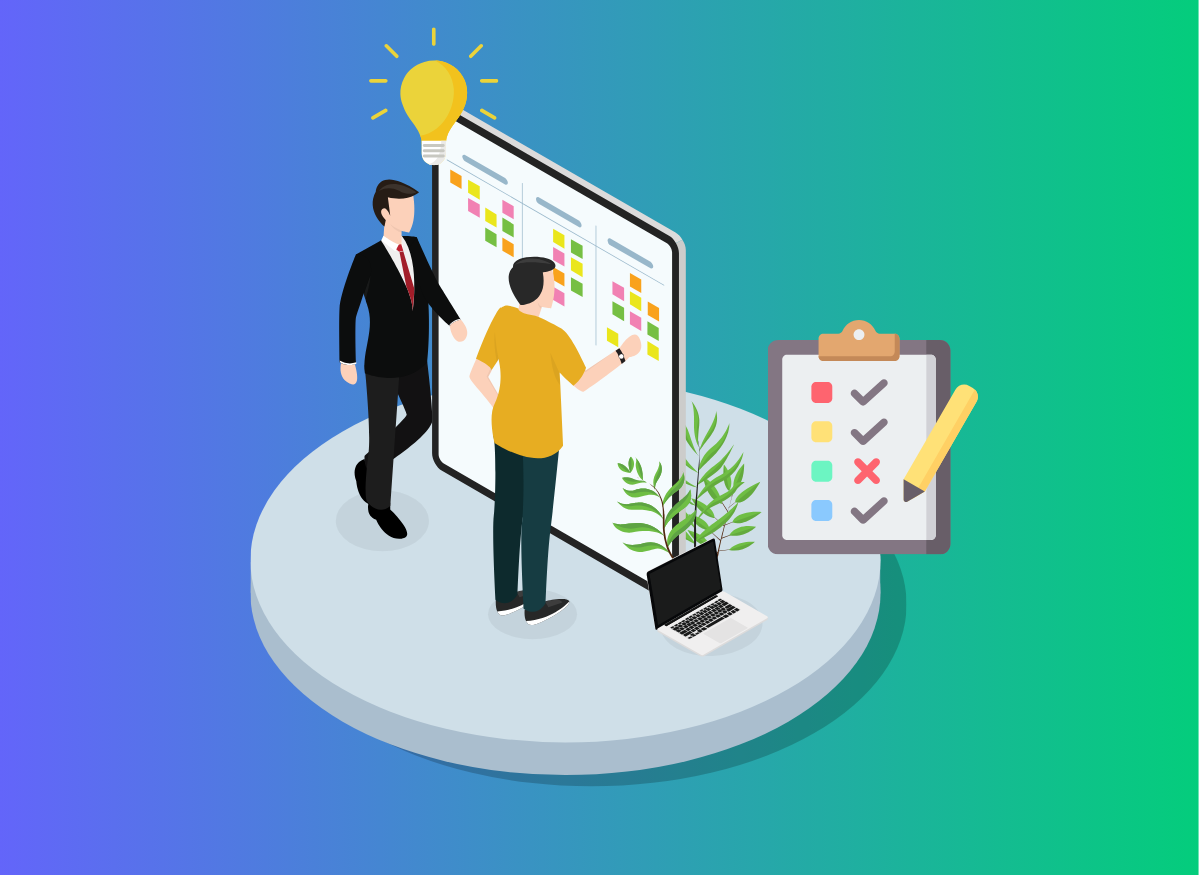
What is meant by project methodology?
Project methodology: definition
A project management methodology is a process of steps, most often documented, to organize the execution of a project. These methodologies have been standardized and published to support your journey, and to leave no room for chance in your planning.
What are the benefits of a project management methodology?
Opting for a project methodology has many advantages. Following a pre-established structure is reassuring, and allows you to gain in efficiency and rigor. Production is finally industrialized, since each operation is clearly identified and structured. The quality of your project deliverables will be even better!
The more orderly the project management, the less you will face budget or schedule drifts – a win for your profitability. A methodology also helps you to better estimate the costs of your projects, deadlines and charges. By following a structure, you are less likely to forget to take into account certain details.
Finally, the project methodology can also include communication phases or methods in its processes. This helps to streamline collaboration between stakeholders.
The project methodology is the overarching framework that defines the logic, principles, and best practices to be followed in managing a project. Method is a process or set of concrete steps applied to a specific task. The tool is a support (Stafiz software, table, template) allowing the method to be implemented within the chosen methodology.
What Are The Different Project Methodologies?
The Waterfall Method
✏️Synonym: waterfall method.
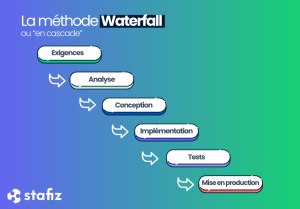
The Waterfall methodology is inspired by the movement of a waterfall. Like it, from the top down, the method unfolds in a linear way and defines the stages of the project. Thus, like a stream of water, there is no turning back once the transition from one stage to another has passed.
Each phase therefore depends on the complete validation of the previous phase, hence the name cascade.
This approach makes it possible to secure your commitments with the client : the latter will be less able to ask for work that was not initially planned. Your teams, on the other hand, benefit from very clear planning.
The UP method, or Unified Process
The unified process methodology is a very robust but quite rigid choice of structure. It is mostly used for software development projects, although it is adaptable for large, complex projects. It is particularly appreciated for its optimal risk management.
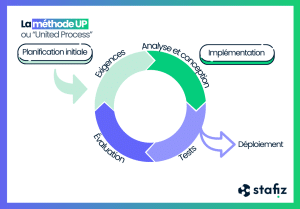
The UP method is divided into 4 phases :
- a design phase,
- a development phase,
- a creation phase,
- a transition phase.
Each phase includes iterations related to the technical development of the product.
The Agile methodology
The agile project management methodology is intended to be flexible. She advocates adaptability and collaboration.
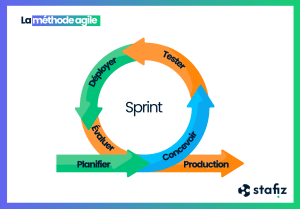
The project is divided into several iterations called sprints. These are then planned, developed, tested and deployed in order to be delivered week after week.
A sprint usually lasts between 1 and 4 weeks. Once sprint 1 is over, we move on to the next one, and so on until the end of the project.
The Pert diagram methodology
The Pert diagram models a project into a network of tasks so that you can easily visualize:
- the duration of the tasks
- dependencies between tasks,
- the critical path.
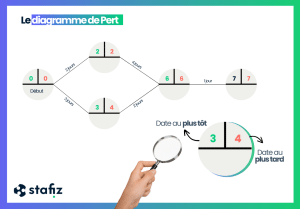
This methodology offers a very visual, but also very structured representation of your project. Using different time scenarios for certain tasks is a great way to provide flexibility, and to integrate uncertainty management into your load planning, among other things.
The Six Sigma Method
This project methodology aims to ensure the best possible quality of delivery . To achieve this, it streamlines operational processes.
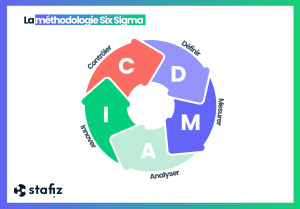
There are two approaches specific to the six sigma methodology:
- DMAIC (Define, Measure, Analyze, Improve, Control): to optimize an existing process.
- DMADV (Define, Measure, Analyze, Design, Verify): to design a new process or product.
This methodology is based on the analysis of measurable data and statistical analyses to identify the causes of risks and proactively address them. This reduces variability and eliminates organizational flaws, in order to strive for an ambitious level of performance, close to perfection.
From the outset, the costs allocated to the project are optimized: only what is necessary and guaranteed success is kept.
The CCPM methodology
The CCPM methodology, or Critical Chain Project Management, is an approach to project management that places the critical chain at the heart of its management. Thus, it differs from the Pert diagram, which emphasizes the duration of tasks. It is structured around resource constraints – both human and material – in order to reduce deadlines as much as possible and thus accelerate the execution of the project.
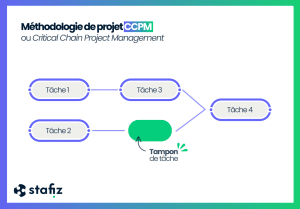
CCPM management optimizes your safety margins through the use of buffers. These buffers are designed to absorb any unforeseen events. If necessary, you can then choose to assign an available resource to a task. Planned throughout the project, they are taken into account during planning to avoid wasting resources in the event of overestimation. This approach then reduces the costs associated with employees, who are no longer at risk of being assigned to missions where, in the end, their intervention is not necessary.
The PRINCE2 methodology
This British project methodology has proven its worth. Now used internationally, it benefits from a dedicated certification.
In particular, she contributes to the governance of projects by ensuring that each mission can be justified and viable for the company from a commercial point of view.
It is based on 7 key principles, 7 themes, and 7 processes.
Its very complete and modular framework adapts to many projects. The PRINCE2 helps to clearly identify roles, responsibilities, steps, and approval workflows.
The Lean Project Management approach
Lean management was originally inspired by Toyota's production methods. It was then adapted to project management to meet the same objective: to focus on high-value tasks to eliminate tasks that do not bring any profit. In this way, lean management aims to eradicate waste, both in terms of costs and time.
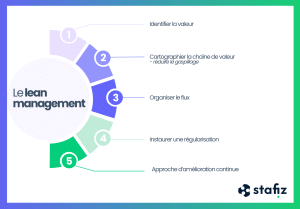
The goal is to make the production of the project smooth, fast and efficient in order to reduce costs and increase profitability. This approach opts for a strong customer focus, the goal being to maximize the value delivered. Customer satisfaction will increase tenfold, as will that of your employees, who collaborate on missions that make sense and stimulate their commitment.
Which Project Methodology Should I Choose?
One project methodology is not inherently better than another. On the other hand, some will be more conducive to certain needs or types of projects.
Here are some tips to follow to help you find the project methodology that suits you.
Depending on the project
- For a short project
Small, short-term projects, such as a technical deployment or a data migration, are most often quite mastered. Clear and well-defined, they leave little room for uncertainty.
The waterfall method lends itself well to this type of project. With no way back, each step must be correctly performed and validated before proceeding with execution.
- For an evolving project
An innovative project inherently contains more uncertainty. Forgetfulness is more likely when it comes to confronting a renewal. An agile or lean management structure is best suited to this type of mission. Consider using one of these methodologies for projects such as product creation, a UX redesign or an organizational transformation.
- For a complex project
A long or complex project, involving many parties and cross-functional teams, we will look for a more rigid, even strict methodology. A certified method, such as PRINCE2, can then reassure customers and management teams. Indeed, all the strategic issues will then be taken into account in the design and planning of the project.
Depending on the customer
The project sponsor can impose a methodological framework for the design. In this case, it is necessary to ensure:
- adapt the method to the client's level of expertise,
- its ability to continuously validate or operate in fixed cycles,
- align project rituals with customer habits.
If these are methodologies that you are rarely confronted with, communication will be all the more important. It is necessary to mobilize and train your teams. The more issues are communicated to them, the more they will be able to adopt the required processes.
The hybrid project methodology
Be careful, if project methodologies offer an organizational framework, they can be shaped to adapt to your environment and your working habits.
Thus, it is common to merge methodologies and use what is known as a hybrid project methodology .
Modernized to the taste of the day, they are less rigid and allow a harmony between the rigour of an associated rigid structure and the flexibility of the execution.
Here are some common examples of hybrid project methodologies.
- Water-Scrum-Fall: The analysis and delivery phases are carried out in a cascade fashion, while development is managed in Agile.
- Agile internally, predictive externally : project teams work in agile mode, but the client requires a fixed schedule and well-defined deliverables.
- Tailor-made method : by selecting the tools, rituals and processes best suited to the teams, the sector or the context of the project.
Common Challenges of Project Methodology in Professional Service
While the structure of a methodology can be reassuring and beneficial, it is not able to promise you an unobstructed execution. In the case of service organizations, adopting a methodology can face some challenges.
Add flexibility
As seen above, some projects need more flexibility. But that balance can be hard to find. Don't panic, Stafiz gives you the flexibility you need, without collapsing your organization!
Budgeting and planning, you can allocate your resources by name or by profile type. During the pre-resource planning, this helps you to block a resource buffer and to readjust with more finesse once the project is won for example.
In terms of time management, you can both keep a strict schedule while taking advantage of a granularity of work time allocation.

Choose to allocate days or half-days, or go further with a detail per hour or minute.
Finally, on the cost management side, the data is naturally integrated into the consolidated accounting of the projects, which allows a good analysis and comparison of the projects in the portfolio.

Overview of projects and their financial status in Stafiz
Link your financial management
By following a methodology to the letter, you risk falling into a trap: that of seeing planning as a fixed dogma. It is not enough to follow the schedule, the financial monitoring of the project is just as essential. It may indeed determine changes to be expected in the planning, depending on the remaining work to be done, budget variances, and the actual state of margins compared to the forecast.
Stafiz's tool allows you to meet these needs by integrating into your project management what you need to monitor time, invoicing, margin forecasting and forecasting.
Link your resource management
Very often, the commercial promise is disconnected from the reality of the project. To avoid putting your business in difficulty, certain points are to be expected from the pre-sales stage. The goal here is to ensure consistency between planning, resources, and execution.
For a more accurate costing assessment, plan your resources in advance to visualize the best possible scenarios while avoiding availability conflicts. Involving your sales teams is also a way of confronting them with the reality on the ground, and of adjusting the ambitions of the project in a reasonable way.
The different project methodologies that exist help you structure your assignments. Each one offers a framework to follow, sometimes to the letter, sometimes as an inspiration. Some projects require more maneuverability, while others move forward in a stricter and more rigid configuration. In order to choose the best project methodology for you, take the time to define the objectives and context of the mission, your work environment, and the client's requirements.
Questions:
The project approach generally follows four main stages: scoping (objectives, scope, resources), planning (planning, budget, assignment of tasks), execution (implementation and monitoring) and closure (balance sheet and capitalization).
Some methodologies add phases of continuous adjustment to incorporate changes.
Governance is defined upstream, by specifying the decision-making structure, validation circuits and monitoring indicators.
Each role is documented with its responsibilities, expected deliverables, and interactions with other stakeholders.
A clear methodology facilitates the distribution of responsibilities and increases transparency throughout the project.


